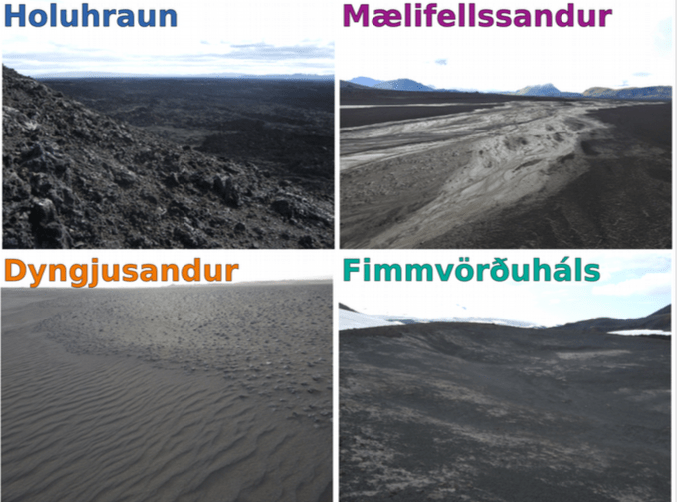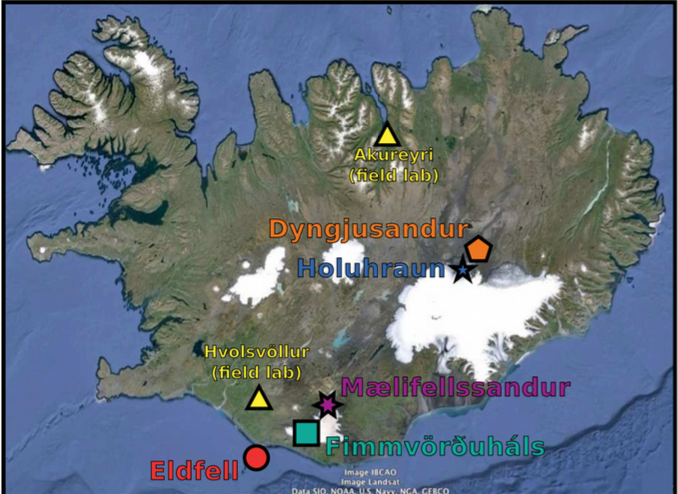FIELD EXPLORATION AND LIFE DETECTION SAMPLING FOR PLANETARY ANALOGUE RESEARCH (FELDSPAR): VARIABILITY AND CORRELATION IN BIOMARKER AND MINERALOGY MEASUREMENTS FROM ICELANDIC MARS ANALOGUES. D. Gentry1, E. Amador2, M. L. Cable3, T. Cantrell4, N. Chaudry5, T. Cullen5, Z. Duca4, M. Jacobsen, J. Kirby5, H. McCaig3, G. Murukesan6, E. Rader7, V. Ren- nie4, E. Schwieterman8, A. H. Stevens9, S. Sutton4, G. Tan4, C. Yin10, D. Cullen5, W. Geppert10, A. Stockton4. 1NASA Ames Research Center (diana.gentry@nasa.gov) 2California Institute of Technology 3Jet Propulsion Laboratory 4Georgia Institute of Technology 5Cranfield University 6University of Turku 7Universities Space Research Associa- tion 8University of California 9University of Edinburgh 10Stockholm University.
For accompanying images please visit: PSTAR_Field_Work_In_Iceland/media
Introduction: In situ exploration of planetary environments allows biochemical analysis of sub-centimeter scale samples; however, landing sites are selected a priori based on measurable meter-to-kilometer-scale geological features. Optimizing life detection mission science return requires both understanding the expected biomarker distributions across sample sites at different scales and efficiently using first-stage in situ geochemical instruments to justify later-stage biological or chemical analysis.
Icelandic volcanic regions have an extensive history as Mars analogue sites due to desiccation, low nutrient availability, and temperature extremes, in addition to the advantages of geological youth and isolation from anthropogenic contamination. Many Icelandic analogue sites are also rugged and remote enough to create the same type of instrumentation and sampling constraints typically faced by robotic exploration [1].
FELDSPAR (Field Exploration and Life Detection Sampling for Planetary Analogue Research) is an ongoing Mars analogue study at recent basaltic eruption sites and basaltic sandy plains in Iceland. The project conducts field operations analogous to a Mars sample return mission, including prior remote sensing, and uses nested sampling grids to characterize the variability within and degree of correlation between physicochemical data and different types of biomarkers at different spatial scales.
We present here intermediate results from the project’s first four years (2013-2017); a further two years of study are planned. As the state of knowledge regarding spatial distributions of biomarkers in extremely low biomass environments is sparse, the conclusions are highly relevant both to other planetary analogue efforts and to future mission planning [2].
Methods: Our primary field sites have been adjusted over the course of the project as the oldest sites have aged and newer ones have become available. Similarly, the battery of instruments and assays used has been refined over the course of the project based on feasibility and early results.
Field sites. Initially primary sites were geologically recent basaltic lava flows (Fimmvörðuháls, Eldfell). After Fimmvörðuháls, a 2010 eruption site, became visibly colonized by macroscopic plant life in 2017, the 2014 eruption site Holuhraun was added. In 2017, the barren basaltic sand plains of Mælifellssandur (dominated by water transport) and Dyngjusandur (dominated by wind transport) were added for comparison. All sample sites were homogeneous at the 1 m to 1 km scale in apparent color, morphology, and grain size, corresponding to simulated coarse remote sensing resolution.
Sampling strategy and analysis. Sample locations were arranged in hierarchically nested grids at 10 cm, 1 m, 10 m, 100 m, and >1 km scales. Simulated remote sensing data was generated from digital elevation models captured by a commercial quad-copter flying at 200 m elevation. Calculated measures of spatial distribution and variability include unbiased sample variance, F- and pairwise t-tests with Bonferroni correction, and the non-parametric H- and u-tests. All final assay results were then then tested for correlation using the non-parametric Spearman’s rank test.
Biomarker assays. Biomarkers were chosen to represent a diversity of types, rather than specific future mission targets. Cell counting, representing overall biomass, was performed by staining sample cell wash with a nucleic acid stain followed by fluorescence microscopy. Adenosine triphosphate (ATP) quantification, affected by cell state and the energy available for metabolism, was performed on sample lysate using a standard luciferin/luciferase assay. qPCR, measuring relative diversity of broad classes of life, was performed using 16S/18S primers for bacteria, archaea, and fungi. Community sequencing was also carried out on a subset of returned samples.
Mineralogical measurements. Mineralogical, chemical, and physical measurements and observations including temperature, pH, moisture content were taken from the beginning of the project. Raman spectroscopy using a field instrument was tested in 2015 but proved impractical; some limited data has been taken on returned samples. Visible and near-IR reflectance spectra and X-ray fluorescence spectra were added in 2017.
Results & Discussion: All assays examined showed significant variability even at the smallest examined scale. Variability typically increased with scale, although cell count showed no clear trend. Biomarker levels were generally well correlated, although again cell count was an exception, showing a notable lack of correlation with any other examined assay.
The spatial scale analyses indicate that, in a region chosen using comparable a priori data with sets of potential sampling sites 1 m apart, between one-third and one-half of those sites would yield statistically significant different biomarker levels. The fraction declines with larger numbers of replicates at larger scales. Cell quantification is, again, the exception, with less than ten percent.
Mineral classification from spectra is still underway. Preliminary data indicates that the predictive value of mineralogy for biomarker levels differs between primary sites.
Conclusions & Future Work: The high overall variability indicates a need for multiple replicates even at a small spatial scale; in the environments we have studied, the ideal case, avoiding reliance on assumptions about distribution, would be a minimum of nine. However, this almost certainly exceeds what is feasible in a planetary exploration context; thus, further study of expected distribution is needed.
The generally high correlation between assays that depend on aggressive extraction and lysis, and the lack of correlation with the much simpler cell count assay, highlight the inseparable effects of sample preparation bias, assay sensitivity, and target biomarker dependence on unmeasured environmental parameters. Selecting multiple complementary final assays, in addition to early-stage triage assays, can enhance confidence in both positive and negative detection.
The ATP bioluminescence assay has proved to be reliable in the field and sensitive even in our challenging field samples, although its time-sensitivity creates logistical challenges. The qPCR assay primary value at this point has been simple DNA quantification, although as the community sequencing work proceeds, use of different primer sets may improve qPCR’s utility. The cell count assay has been a significant bottleneck due to the lack of a high-quality field microscope camera, and may be replaced. Lastly, as we have observed substantial increases in measured ATP levels when samples are re-tested a few days after collection, an additional assay to differentiate spores from dormant or active cells in future expeditions may provide additional perspective.
Pairwise comparisons proved to be the most intuitive and useful measure of variability, as it yields a percentage of sites expected to be statistically different from one another for a given assay and environment type. The group variability assays were too sensitive, ranking every scale as highly distinct, and the non-parametric statistical tools required an impractical number of replicates. Future analyses will include additional tools for landscape and ecological characterization.
Lastly, this study is an initial effort to characterize the distributions of terrestrial biomarkers and potentially relevant geochemical markers in Mars analogue environments, which are typically very low biomass and have uncommon nutrient and environmental limitations. The nested sampling method combined with pairwise t-tests have proven very useful, and could be applied to or combined with many other analogue studies.
References: [1] Amador, E. et al. (2015) Planet. Space Sci., 106, 1-10. [2] Gentry, D. et al. (2017) Astrobio., 17(10), 1009-21.































